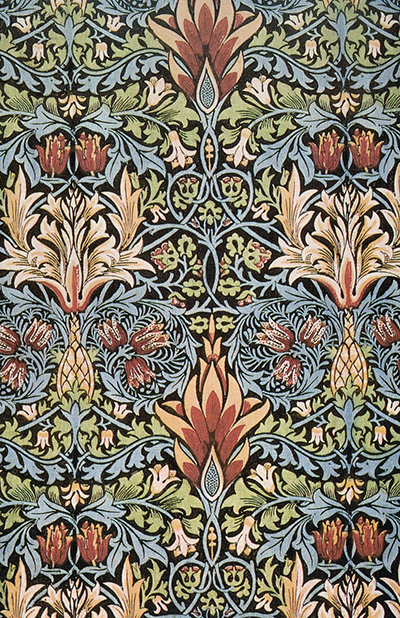The Snakeshead design was completed many years before it was eventually released as a printed, manufactured fabric. Various dates have been put forward, with the most likely scenario being 1876-1877 for the original design and 1917–40 for its manufacture.
This memorable piece features some breathtaking bright tones which were delivered with natural dyes. We find yellows and reds here which contrast against the darker blue that runs along the background. It is an intense, lively pattern in which an endless array of plants and foliage intertwine. William Morris lay behind this design and would have been in his early forties at the time that he put this piece together, though it was released through Morris & Co. It is reported that he spent several months tweaking the design alongside a dye chemist before settling on this completed look. Many of Morris' designs would not be ready for manufacture right away and would need plenty of amendments between the design phase and the point at which customers could purchase it. The printed textiles featured the company logo on their side, boosting the professional finish afforded to the company's considerable customer base. Sadly, the artist would have passed away many years before Snakeshead was finally manufactured and sold to the public, which is estimated at being from around 1917 at the very earliest.
Like many Victorian artists, Morris would look abroad for inspiration. He took ideas from Indian cotton, where natural dyes were used and found that these worked much better than the chemical alternatives that were appeared within the UK at this time. Snakeshead was delivered using the more traditional methods and several examples of this piece can be found in art galleries and museums in the UK and US, with it being considered one of his most popular designs. He believed that the Indian approach would give brighter tones which lifted his designs to a new level and so he went about learning and passing on these production skills so that they continued within the UK. Such an approach today would be particularly lauded, because of our new-found desire to protect the environment and try to move away from some of the negatives of low-cost, mass production. In that sense, Morris was well ahead of his time and perhaps would have been shocked by how far things would develop in the next century after his death.
Information uncovered on the Snakeshead fabric have revealed that four different blocks were required to put this design together, and the entire process would have been by hand, in keeping with Morris' approach throughout his career. These traditional methods would bring better results, but also be particularly time consuming and this would be reflected in the pricing of the company's products. Some designs would be more complex than others, or require more expensive materials. Today these designs can be offered through modern techniques, though many prefer to see the originals which can be found in a number of museums based in and around London, UK. Several organisations have been set up in the artist's name and they help to continue to spread word of the artist's career to new generations, as well as further abroad to the US, Europe and Japan.




